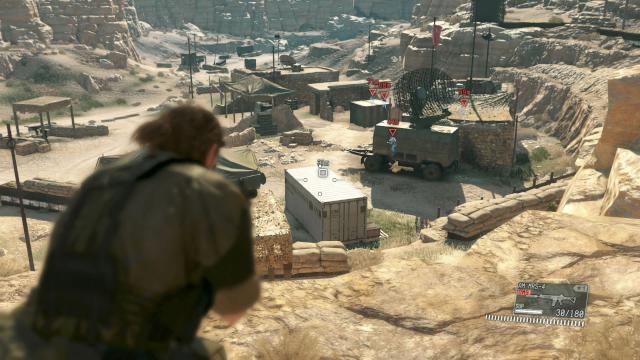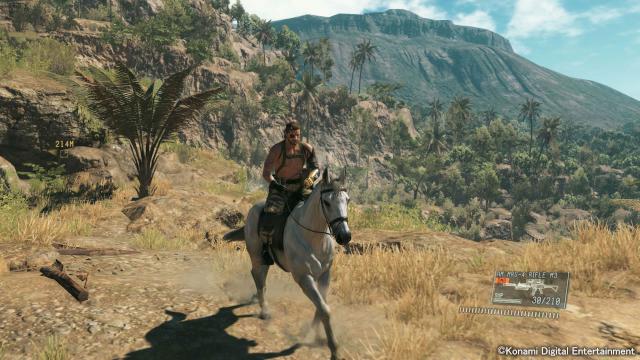
As the helicopter swoops low across the Afghan terrain, Big Boss swings the door open and sits casually with his legs dangling over the edge. In the near distance an enemy camp, complete with watch towers, machine gunners and a dozen compact buildings host a prisoner who I’ve been sent to break out without getting spotted. My trusty horse is waiting for me at the landing zone, so I hope and and make my way to the target, stopping just in time so as to not get spotted by a checkpoint in the road.
Now what? Well, probably best I get rid of them. A few shots from the tranquiliser pistol and three guards are having a little kip on the floor. Thanks to some neat gadgets researched by the guys back at base I’ve already scanned each of them to see who might be a valuable addition to my crew, and moments later they’re attached to a huge balloon which has lifted them up to be picked up and taken back to my centre of operations in the middle of the sea.
So far, so good.
But it doesn’t last. When I reach the base I try to grab a guard and question him to find out the exact location of the prisoner, but I’m spotted. Hell breaks loose, shit hits fans and spanners end up in various works. All of a sudden the enemy are working together against me, flanking my last known position and sending mortar shells to flush me out. It wasn’t meant to pan out like this. And in previous Metal Gear games this would be exactly the moment that the success of the mission was pretty much in tatters, the inevitable gunfight and bloodshed enough to drop your rank right down and make you feel bad for hurting someone.

But not any more. You see, The Phantom Pain does away with forcing you to play in a certain way. Instead, improvisation is key. You’ve got dozens of gadgets and weapons to try out, you can pick up a dog and nurture him into a hunting, fighting machine to take onto the battlefield. You’ll meet other soldiers to fight alongside you, themselves coming with their own set of researchable weapons. It all adds up to give you multiple ways to approach a scenario – if you want to go in loud and send a volley of gunfire and bombardments towards the bad guys then there’s nothing stopping you other than the assurance that you’ll have a heck of a battle on your hands. But I found moments when only that approach worked, keeping a safe distance with a sniper rifle instead of trying to sneak up on larger groups of bad guys, calling in air strikes to either smoke out the area or just cause destruction and confusion among the enemy. Sneaking is still very much the way to go in most situations, but it’s incredibly refreshing to know you’ve got the option of how to proceed.
As for where all this will be happening, we’re looking at two vast open world settings in Afghanistan and Zaire, areas you can wander round entirely at will either completing the huge numbers of side missions, hunting round for roaming soldiers to kidnap and join your own fledgling army or just gathering plants and other resources for the guys back at base. It’s not quite as easy as just picking where to go though; this is a living world, and enemy patrols could drive past at any time, an angry bear might take a liking to the idea of a Big Boss flavoured lunch or you might come across a heavily guarded outpost or bridge between you and your destination. You can go where you want, but expect to be opposed before too long.
But what of this base I keep mentioning? That’s the long-term hook in The Phantom Pain, and also the home for one of the game’s multiplayer options. Collecting resources and stealing gear from the enemies all go towards you being able to build up your Mother Base out in the sea, a small oil platform which grows as you unlock and build further bases. These allow further research and medical facilities, and once you hit a certain level can get attacked by other players, leading to some excellent cat and mouse antics around your own base. It’s another string to MGS’s bow, another activity to keep you popping back even after you’ve hit those final credits, and another reason to think that this might be one of the best value-for-money games we’ve ever seen.

The best bit though is the fact that the storyline is genuinely engaging. Gone are the massive cut-scenes which made previous MGS games a bit tiresome in places, and instead the story is told in a much more punchy way throughout. There are some incredible twists throughout the game, from the ghostly creatures who come and go for reasons which aren’t clear for quite some time, through to facing children as an enemy. Yeah, children. With guns. And they’ll kill you if you don’t sort them out first or run away crying when you hear the reactions of one of them when they see a friend of theirs old cold on the floor. It’s a jarring moment when you realise what’s going on, but I’m incredibly impressed with how it’s handled and set up – after all, that’s hardly an unheard of occurrence nowadays. It does totally change how you approach a situation though, and with certain methods of combat not working in the same way you’ll have to totally rethink how you go about your approach…
It’s almost impossible to cover everything here, but like Skyrim and GTA 5 before it, The Phantom Pain is a game I can spend hours upon hours doing absolutely nothing. There’s so much to do, so many side missions, so many things to find and hunt for, so many enemies to scan and capture, so many music tapes to find for your background music, so many new areas to discover and search… you’ll get dozens upon dozens of hours out of this, and even having played it once there’s nothing to stop you playing through again and trying things a little differently. If you only want to buy one game before the end of the year, this is one you very seriously need to consider.
Reviewed on PS4


Leave a Reply